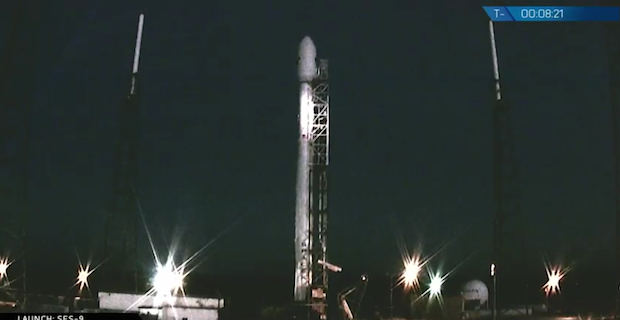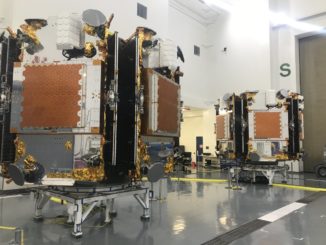
SpaceX kept an upgraded Falcon 9 rocket on the ground Thursday after running into a problem loading super-cold liquid propellants into the launcher’s fuel tanks, postponing blastoff of a commercial communications satellite for the second day in a row.
The California-based rocket company did not say when the next launch attempt could occur.
The Falcon 9 rocket’s countdown proceeded normally Thursday until a member of the SpaceX launch team called a hold at approximately T-minus 1 minute, 41 seconds, before the scheduled launch time of 6:47 p.m. EST (2347 GMT).
The cause of the last-minute abort was an issue with loading cryogenic liquid oxygen into the rocket, according to a SpaceX official on the official launch webcast. Both stages of the Falcon 9 burn a mixture of RP-1 kerosene fuel and liquid oxygen.
SpaceX released no other details on the problem, only tweeting: “Countdown held for the day. Teams are reviewing the data and next available launch date.”
The Falcon 9 launch team continued to troubleshoot the rocket’s fueling system after Thursday evening’s scrub to identify the problem and develop a fix.
The SES 9 communications satellite fastened atop the 229-foot-tall launcher has been delayed more than six months after a Falcon 9 failure last year grounded SpaceX’s workhorse fleet.
Engineers called off a launch attempt Wednesday less than an hour before liftoff to allow the Falcon 9’s liquid oxygen supply to cool off to the desired temperature, a requirement for the latest iteration of SpaceX’s rocket.
The first flight of the upgraded launcher in December carried 11 small communications satellites into orbit, and SES 9’s flight marks the second launch of the new rocket model.
Designed to loft heavier cargo into space, the upgraded Falcon 9 burns a super-chilled mixture of RP-1 and liquid oxygen.
The modified Falcon 9 consumes a super-chilled propellant mix that allows engineers to load additional fuel into the rocket. The cryogenic liquid oxygen is chilled closer to its freezing point, from minus 298 degrees Fahrenheit to minus 340 degrees, while the Falcon 9’s RP-1 fuel — a refined form of kerosene — is cooled from a standard room temperature of about 70 degrees Fahrenheit to 20 degrees, according to Elon Musk, SpaceX’s founder and CEO.
The change essentially allows engineers to load more propellant mass into the the volume of the Falcon 9 fuel tanks, which are also slightly enlarged on the upgraded rocket. The denser fuel mix flows faster into the rocket’s Merlin engines, adding extra thrust to haul heavier satellites into orbit and leaving leftover fuel to attempt landings of the booster for future reuse.
The first stage’s nine Merlin 1D engines collectively generate 1.5 million pounds of thrust at sea level, up from 1.3 million force-pounds on the earlier version of the Falcon 9. All told, the changes allow the Falcon 9 to deliver about 30 percent more mass to orbit without extra thrust from strap-on boosters or other major additions to the booster, according to SpaceX.
The upgrades also allow SpaceX to recover the first stage of the Falcon 9 on more launches, a capability previously limited by the type of mission it performed.
SpaceX engineers struggled to master the handling of the super-cold densified propellants at the Falcon 9 launch pad before the maiden flight of the upgraded rocket in December, but the rocket successfully took off the first time it received propellants on a real launch attempt.
The launch team updated the Falcon 9’s countdown procedures to account for the sensitivity of the super-chilled propellants.
Instead of loading the propellants three hours before liftoff, the upgraded Falcon 9 receives its fuel in the final 30 minutes of the countdown to minimize the time the cryogenic liquid sits inside the rocket tanks and warms up in the mild ambient temperatures of Florida’s Space Coast.
Email the author.
Follow Stephen Clark on Twitter: @StephenClark1.



